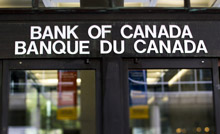
The hiring and investment intentions of Canadian companies have dropped to their lowest levels since 2009 as the fallout from sliding commodity prices seeps beyond resource-rich regions, a new survey has found.
Companies are anticipating a darker road in 2016 with many facing “significant challenges” tied to the commodity and energy price plunges, according to the Bank of Canada’s latest business outlook survey.
“The negative effects of the oil price shock are also increasingly spreading beyond the energy-producing regions and sectors,” the central bank said in the quarterly report released Monday.
“For example, many businesses across the energy supply chain continue to struggle as they adjust to an environment of weak demand.”
As a result, the poll found fewer firms expected to boost employment over the next 12 months, while plans to cut staff were more “widespread” with many companies citing a need to cut costs, the survey said.
These hiring plans tumbled to their lowest level since the 2009 recession, the Bank of Canada said.
Meanwhile, investment expectations for equipment and machinery also hit their lowest point in seven years. Many firms planned to curb spending to repair and replace existing equipment and, compared with recent surveys, the bank said there were fewer plans to expand production.
The survey’s interviews were conducted between mid-November and early December. Oil prices and the dollar have since slid even further.
The disappointing conclusions in the poll prompted at least one analyst to predict the Bank of Canada will cut its trend-setting interest rate at its next scheduled policy announcement Jan. 20.
Canada’s resource-dependent economy hobbled through 2015, a year that saw economic growth go in reverse over the first two quarters.
The public purse has also taken a major hit from the price slide. The federal government has downgraded the country’s fiscal outlook for the coming years, removing billions from the bottom line.
The survey did say, however, that exporters remained optimistic that sales will benefit from strengthening foreign demand over the coming year, particularly amid widespread expectations of growth in the U.S. economy.
The questionnaire also found that some firms believe the lower dollar will boost foreign sales and tourism-related business. However, the cheaper loonie also hikes the cost of products and services companies need to import from outside Canada.
Emanuella Enenajor, senior economist for Bank of American Merrill Lynch Global Research, now projects the Bank of Canada will lower its benchmark rate later this month for the third time in a year.
At the moment, the majority of analysts expect governor Stephen Poloz to hold off on moving the rate.
But Enenajor said her firm, which is forecasting Canada to show negative 0.4 economic growth over the final three months of 2015, thinks Poloz will drop the rate to 0.25% from 0.5%.
“Really, it’s been a been a constant barrage of disappointments, but in the last month I think the data have been particularly bad,” Enenajor said in an interview.
“I would say that there are a lot of concerns with the breadth of this economic weakness that we’ve seen.”
The survey results were the most important piece of information ahead of Poloz’s upcoming rate decision, Leslie Preston of TD Economics wrote Monday in a research note to clients.
“Unfortunately it does not paint a very positive picture about hiring or investment over the next 12 months,” she wrote.
Preston conceded that market speculation for another rate cut on Jan. 20 had increased, but said it would be premature with the effects of the central bank’s two 2015 reductions still working their way through the system.
She also noted the survey remained consistent with the theme of Poloz’s speech last week in which he described Canada’s hurdles as a difficult adjustment to low commodity prices.
Poloz said at the time that no simple policy response would fix the problem of falling commodity prices. The sometimes painful economic forces underway must work themselves out, he said.
Poloz also said that divergence on monetary policy has become a dominant theme as the various world economies face different obstacles. His remarks came only a few weeks after the U.S. Federal Reserve raised its key interest rate for the first time since before the financial crisis.
He also reiterated last week how the Bank of Canada has several unconventional tools it can use to limit any significant threats to the financial system. Among them is the bank’s ability to lower the key rate into negative territory, if necessary.
On Monday, the Bank of Canada also released the results of its latest senior loan officer survey, which focuses on business-lending practices over the final three months of last year.
It found that overall lending conditions had become more difficult for firms during the fourth quarter. Meanwhile, overall demand for credit was roughly unchanged.